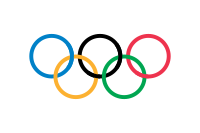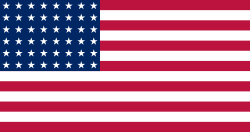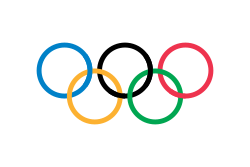Olympiska vinterspelen 1928
| Den här artikeln behöver källhänvisningar för att kunna verifieras. (2019-09) Åtgärda genom att lägga till pålitliga källor (gärna som fotnoter). Uppgifter utan källhänvisning kan ifrågasättas och tas bort utan att det behöver diskuteras på diskussionssidan. |
| Olympiska vinterspelen 1928 | |
 | |
| Grenar | 14 grenar i 4 sporter |
|---|---|
| Deltagare | |
| Nationer | 25 |
| Aktiva | 454 |
| Män | 438 |
| Kvinnor | 26 |
| Värdskap | |
| Land | |
| Ort | Sankt Moritz |
| Arena | Eisstadion Badrutts Park |
| Invigning | 11 februari 1928 |
| Spelen öppnades av | Edmund Schulthess (Ordförande i förbundsrådet) |
| Läste deltagarnas ed | Hans Eidenbenz |
| Avslutning | 19 februari 1928 |
Olympiska vinterspelen 1928, de andra (II) olympiska vinterspelen, arrangerades i Sankt Moritz, Schweiz. Staden ligger på cirka 1 800 m höjd, och under längdlöpningen på skidor kom spåren att passera 2 000 metersgränsen. Ca 40 000 åskådare bevistade tävlingarna.
Föhnvinden, som förde med sig varm luft från Afrika, ställde till det ännu mera för skridskotävlingarna. 10 000 meter kunde inte fullföljas eftersom isen mer eller mindre försvann. Eftersom tävlingarna gick alldeles för sent på senvintern och man kunde befara fortsatt värme var det inte möjligt att köra om loppet.
Gillis Grafström lyckades med bedriften att hämta hem den tredje raka guldmedaljen i konståkning. Den 15-åriga norskan Sonia Henie tog sensationellt hem damernas konståkningsguld och det skulle dröja 74 år innan någon yngre skulle bli guldmedaljör.
Sporter
Demonstrationssporter
Deltagande nationer
25 nationer skickade deltagare till spelen.
Medaljfördelning
Värdnation (Schweiz)
| Pl. | Nation | Guld | Silver | Brons | Totalt |
|---|---|---|---|---|---|
| 1 | 6 | 4 | 5 | 15 | |
| 2 | 2 | 2 | 2 | 6 | |
| 3 | 2 | 2 | 1 | 5 | |
| 4 | 2 | 1 | 1 | 4 | |
| 5 | 1 | 0 | 0 | 1 | |
| 5 | 1 | 0 | 0 | 1 | |
| 7 | 0 | 3 | 1 | 4 | |
| 8 | 0 | 0 | 1 | 1 | |
| 8 | 0 | 0 | 1 | 1 | |
| 8 | 0 | 0 | 1 | 1 | |
| 8 | 0 | 0 | 1 | 1 | |
| 8 | 0 | 0 | 1 | 1 | |
| Total | 14 | 12 | 15 | 41 | |
Externa länkar
- Olympiska rörelsen
- Officiell rapport
- Programmet för olympiska vinterspelen 1928
 Wikimedia Commons har media som rör Olympiska vinterspelen 1928.
Wikimedia Commons har media som rör Olympiska vinterspelen 1928.
|
Media som används på denna webbplats
Författare/Upphovsman: Tkgd2007, Licens: CC BY-SA 3.0
A new incarnation of Image:Question_book-3.svg, which was uploaded by user AzaToth. This file is available on the English version of Wikipedia under the filename en:Image:Question book-new.svg
Författare/Upphovsman: Gutten på Hemsen, Licens: CC0
Flag of Norway with colors from the previous version on Commons. This file is used to discuss the colors of the Norwegian flag.
Pictograms of Olympic sports - Ski jumping
Flag of Hungary from 6 November 1915 to 29 November 1918 and from August 1919 until mid/late 1946.
US Flag with 48 stars. In use for 47 years from July 4, 1912, to July 3, 1959.
Olympic Rings without "rims" (gaps between the rings), As used, eg. in the logos of the 2008 and 2016 Olympics. The colour scheme applied here was specified in 2023 guidelines.
Pictograms of Olympic sports - Speed Skating
Pictograms of Olympic sports - Skeleton
Pictograms of Olympic sports - Ice hockey
Flag of Germany with a 3:2 ratio, instead of 3:5. The 3:2 version was used by the German Confederation and the Weimar Republic. See Flags of the World for more information.
Författare/Upphovsman: F l a n k e r, Licens: CC BY-SA 2.5
Flag of the Kingdom of Sardinia (1851-1861) and of the Kingdom of Italy (1861-1946). Use: Civil flag and ensign. In a governmental or a military context, the crowned version (see Crowned version) was always used (as State flag and naval ensign).
Pictograms of Olympic sports - Bobsleigh
Pan-Slavic flag. Emerged from 1848 Prague pan-Slavic conference, or interpretations of the resolutions of the conference. Drawn by Fibonacci.
Olympic Movement flag
Proportions 2:3, created 1913, adopted 1914, first used 1920.
- Colors as per http://fairspielen.de/wp-content/uploads/2015/09/Annexe-3-Olympism_and_the_Olympic_Symbol_-_Principles_and_Usages_Guide-1.pdf
- blue: PMS 3005C
- yellow: PMS 137C
- black: PMS 426C
- green: PMS 355C
- red: PMS 192C
- Dimensions of the rings taken from http://fairspielen.de/wp-content/uploads/2015/09/Annexe-3-Olympism_and_the_Olympic_Symbol_-_Principles_and_Usages_Guide-1.pdf
Pictograms of Olympic sports - Nordic combined
The Canadian Red Ensign used between 1921 and 1957.
This image has compared for accuracy (mainly colors) using an image from World Statesmen. The only change is making the maple leaves green from red. This image has compared for accuracy (mainly colors) using an image from World Statesmen. The most recent version of this image has changed the harp into one with a female figure; see [http://flagspot.net/flags/ca-1921.html FOTW
Flag of Mexico (1916-1934)
The civil ensign and flag of Belgium. It is identical to Image:Flag of Belgium.svg except that it has a 2:3 ratio, instead of 13:15.
Pictograms of Olympic sports - Figure skating
Pictograms of Olympic sports - Cross country skiing





































